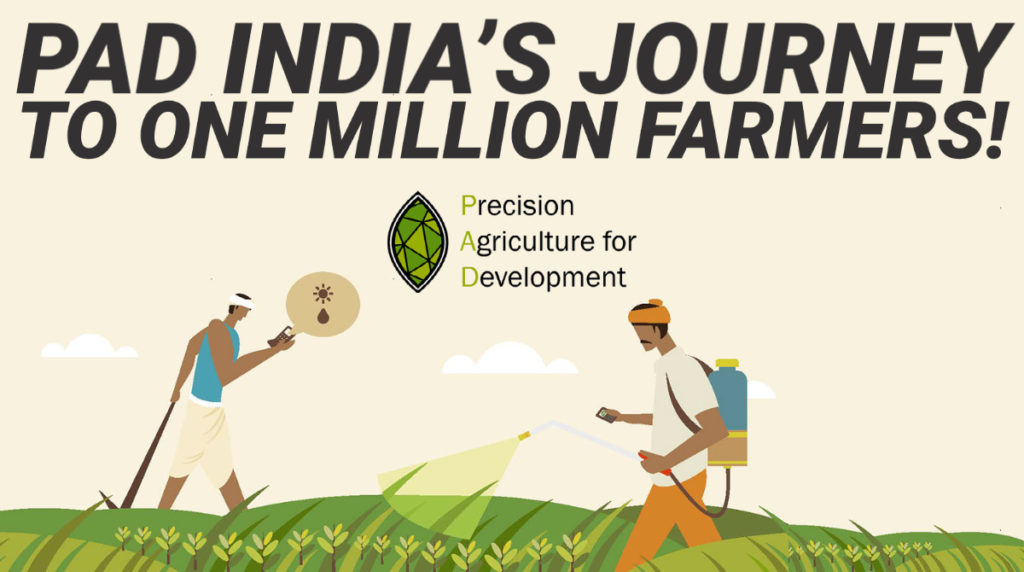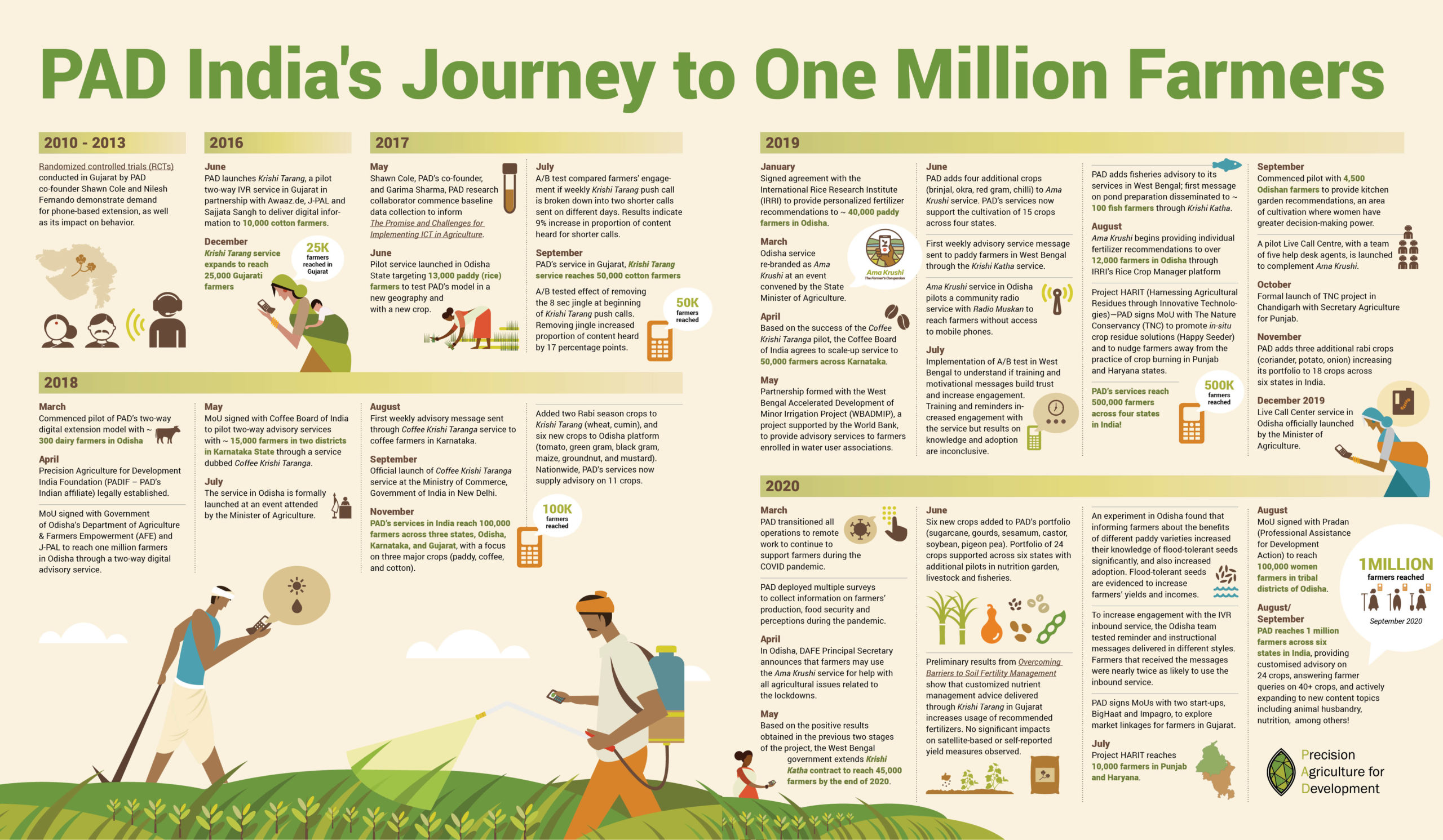The Journey to One Million: PAD in India
- September 24, 2020
- 13 minutes read
Niriksha Shetty, PAD’s India Country Director, reflects on a remarkable milestone.

In September, 2020, Precision Agriculture for Development in India* surpassed the 1 million mark for farmers who receive advisory content through our services. This is a remarkable milestone!
What began in 2016 as a small pilot project in one state – Gujarat – serving just 10,000 farmers on one crop – cotton – has since grown to encompass five initiatives across six states in India which cater to a wide variety of farmers’ informational needs. Today we offer customized and scientifically validated advisory information on – at last count – 24 crops and a litany of pests and diseases. In addition to crops, our advisory capabilities in India now also include campaigns to support fisheries, with planned expansions to dairy, and livestock management.
To achieve these advancements, PAD India collaborated with a set of dynamic and committed partners including government, nonprofit, and for-profit entities. Our partners enable us to scale much more rapidly than would have been the case if we had worked alone as they help bring access, resources, and expertise that would be difficult for us to accrue quickly as a start-up organization (farmer databases, government contacts, etc).
Critically, PAD India’s growth trajectory would not have been impossible without the contributions of two key stakeholders: our farmers and our colleagues across PAD. Two-way information flows allow us to communicate and learn from our farmers, refine our content, improve our service and improve our delivery mechanisms. The entire PAD team works tirelessly to learn from our farmers, iterate our services, and implement improvements to push the frontiers of our impact.
The PAD Model
Our team has pioneered a method of service design and delivery that is evidence-led and iterated through learning. At PAD, we best serve our farmers when we use evidence to inform our decision-making and design choices. We believe in continuous testing, iteration, and refinement to build and expand our evidentiary base and learning. Whether our research findings are ‘good’ or ‘bad’, we endeavor to extract insights about what is working and what could be done better.
We gather and interpret data, and apply PAD’s principles of human-centered design and have built our information services from scratch. For example, we have run trials to understand which voice our users preferred for content delivery, and tested whether adding a jingle at the beginning of a message increased engagement (spoiler: it did not). Today, if you visit any of of program offices – in COVID-times, our home offices and ‘Zoom-rooms’ – you will encounter a hive of activity: agronomists recording answers to farmer queries in sound-proof rooms, enumerators collecting farmer data over the phone, and management teams brainstorming strategies to improve user experience or measure impact.
For PAD India, our advisory content is disseminated through a two-way mobile phone-based platform that delivers customized content to farmers in audio form and in their local language. Farmers receive i) a weekly push call with agricultural advisory information that is customized in line with the crop cycle, each farmer’s location, and land characteristics; and ii) access to a hotline where farmers can record questions that are answered within 48 hours by our team of agronomists, with answers disseminated through pre-recorded voice calls. Farmers who dial into our hotline can also choose to listen to a library of advisory messages and, in some instances, access crop and commodity price information.
Ensuring that the information we provide is targeted and relevant to individual farmers is critical to ensuring sustained engagement and the maximization of potential learning and benefits. When we first engage with farmers to register them to our services, we collect farmer-specific information (what crops are they growing, where is their farm located, land type, time preferences for receiving information, etc.). These details allow us to customize messages in line with farmers preferences, conditions and needs, and ensure their relevance and applicability.
Farmers are then grouped into clusters to receive different information. For instance, our work in Odisha spans six varied agro-climatic zones: farmers in Western Odisha – characterized by hot and moist sub-humid weather – receive advisory later than their counterparts in other climatic zones due to late onset of monsoon in that region, while farmers in the East and South Eastern coastal plains receive advisory on post-rain management of crops after periods of heavy rainfall. Similarly, an arabica coffee farmer in Karnataka may receive pest management information for white stem borer, while a robusta farmer may receive advisory for the coffee berry borer which loves to plague that varietal.
Relevance drives engagement. Across all of our initiatives in India our farmers pick up, on average, 66% of the calls we push to them, and – in turn – listen to, on average, 68% of the message content, with higher engagement during peak-activity periods in a given agricultural season. Our farmers value our service: rating our content greater than 4 out of 5, where 5 represents ‘excellent’. In weekly feedback surveys which we administer with a random subset of users, over 90% of farmers indicate that they would be willing to recommend our service to their friends and family.
A/B testing and experimentation are embedded in all of our operations to ensure continuous learning and to inform improvements to service delivery and impact. In West Bengal, we see that training and testimonials increase engagement with the IVR hotline, but don’t show significant effects on knowledge and adoption of recommended practices while in Odisha, we have learned that simple reminder messages are a more effective way of increasing traffic to the IVR hotline than conversational or dramatized messages. Midline analysis from our most recent A/B test to promote flood-resistant seeds in Odisha show that advisory messages that reiterate the benefits of these seeds have a large and significant impact on farmer knowledge.
As we continue to test methods to increase user engagement, we work constantly to improve our platforms and adjust them to farmers’ needs. For example, as more and more of our farmers report that they own smartphones, an opportunity to engage with them via this dynamic new channel becomes more viable. An early experiment is how we are rolling out automatic farmer enrollment through webforms accessible via smartphone.
Highlights of PAD India’s Programming

Ama Krushi – Odisha
In Collaboration with the Department of Agriculture & Farmers’ Empowerment, Govt. of Odisha
In 2018, we launched what is now our largest and most sophisticated project in India, the Ama Krushi service in collaboration with the Government of Odisha’s Department of Agriculture and Farmers’ Empowerment and the Abdul Latif Jameel Poverty Action Lab (J-PAL), with support from the Bill and Melinda Gates Foundation. This project was conceptualized as a build-operate-transfer (BOT) project with a target of serving a million farmers within a three-year period. In addition to the two-way IVR platform, Ama Krushi operates a live call center and is making forays into integrating smartphone-enabled tools, community radio and additional delivery channels.
Knowing that a key deliverable is ultimately to hand over the service to government, we have worked to ensure that Ama Krushi is embedded within the government apparatus to build ownership and ensure long-term sustainability: All content is co-created with a committee of government experts and scientists from the local agricultural university, data on farmer engagement and information needs are shared in government decision-making meetings, and critical alerts from the government are shared with the hundreds of thousands of farmers through the service.
Coffee Krishi Taranga – Karnataka, Kerala and Tamil Nadu
In Collaboration with the Coffee Board of India
In July 2018 we launched a pilot with the Coffee Board of India to test our model of agricultural extension in the service of coffee growers in Karnataka state. In this setting, in addition to coffee cultivation advisory content, we tested the use of our IVR hotline to provide price information to farmers. Premised on the success of this initial pilot, known as Coffee Krishi Taranga, this service is now being scaled in additional Indian coffee-growing regions in the states of Kerala and Tamil Nadu.
Krishi Katha – West Bengal
In Collaboration with the West Bengal Accelerated Development of Minor Irrigation Project
In July 2019, we joined forces with the Accelerated Development of Minor Irrigation Project, a collaboration between the Government of West Bengal and the World Bank to promote access to irrigation in the state by creating Water User Associations (WUAs). PAD supplemented the intervention by providing agricultural advisory information to farmers enrolled in WUAs. The initiative, known as Krishi Katha, commenced as a pilot serving 10,000 farmers with information on horticultural crops, including paddy (rice) and vegetables, as well as content on fisheries. Following a very successful first season, the project was initially scaled to reach 20,000 farmers, and will reach 45,000 farmers by the end of 2020.
Project HARIT (Harnessing the power of Agricultural Residues through Innovative Technologies) – Punjab and Haryana
In Collaboration with The Nature Conservancy (TNC), the International Maize and Wheat Improvement Center (CIMMYT) and the Borlaug Institute of South Asia (BISA)
In the northern states of Punjab and Haryana, we are piloting a program to encourage farmers to use an in-situ crop residue solution – utilizing a technology called Happy Seeder – in lieu of crop burning practices that are the primary driver of seasonal air pollution throughout the sub-region. By returning crop residues to the field, the pilot encourages farmers to adopt sustainable residue solutions that promote soil health and the development of soil nutrients, in addition to mitigating crop burning practices.
Krishi Tarang – Gujarat
In Gujarat, we work with close to 54,000 farmers, who have been part of PAD’s oldest program in India. While these farmers primarily grow cotton, we also provide advisory on wheat, cumin, oilseeds and other horticultural crops. This service is operated entirely by PAD, and often serves as a setting for testing innovations and piloting new partnership models. Most recently, we have launched collaborations with two start-ups in the agricultural sector to provide farmers with value-added services in addition to advisory and more effectively connect them to input and output markets.
Navigating COVID
Of course, the impact of the current COVID-19 pandemic has fundamentally affected PAD’s operations across all the countries where we work. We continue to adjust to meet the evolving needs of our “new reality” and the emerging needs among our farmers. For example, PAD India moved all of our operations to work from home in early March in less than one week, as my colleagues document in this blog. In doing so, PAD India continued profiling, training, and surveying activities, and maintained management of research and operational work streams without interruption.
PAD India has also had to adjust quickly to meet farmer and government needs during the pandemic. We conducted several rounds of Covid-19 surveys to systematically understand the challenges that farmers and agro-dealers were facing. We disseminated critical advisory information to farmers to inform them about which markets were open, the prices of crops, government notices and alternate remedies in the event of market shut-downs. All the while, we continued to add new farmers to our services at a time when traditional extension activities have all but come to a standstill.
I am proud to say that our information provision in the service of India’s smallholder farmers has proceeded without interruption. This is something that would not have been possible without the hard work and commitment of our team. Of course there have been some disappointments: we had to cancel an all-India staff meeting (we continue to look forward to it), we had to postpone the roll-out of a long-planned impact evaluation in Odisha and we continue to navigate challenges relating to when we can safely return to in-person work and how to best support our staff during difficult times.
Looking to the Future
Digital interventions can be revolutionary, but they can also leave less digitally proficient farmers, as well as women, indigenous communities and older farmers behind. All of these categories coincide with generational and entrenched fissures in the communities in which we work. We constantly challenge ourselves to work to reduce these digital gaps.
As we have scaled, we have learned – sometimes with difficulty – that a one-size-fits-all approach does not work. Our primary informational delivery channel remains our two-way voice-based service, but we are now also working to provide extension services through other channels; for example, through community radio to farmers who have no access to mobile phones. Another approach is by working with grassroots organizations like Pradan, which works with women in agriculture to nudge and promote information sharing across community networks by targeting group and community leaders. Finally, we have tested content on nutritional kitchen gardens that benefit household consumption, and have promoted advisory on horticultural crops and livestock that are more likely to engage women farmers.
As we look forward, however, we are excited about an ambitious pipeline of activities for PAD India. We plan to integrate PAD’s in-house technology stack (“PADDY”) across the various geographies we work in. To date, we have served our farmers in collaboration with our technology partner, Awaaz.de. We are grateful for the strength of our collaboration, particularly during this COVID-affected transition period. We are also excited to have commenced transitioning Ama Krushi to government management, while simultaneously rolling out baseline data collection for a large-scale randomized evaluation of the service. Across geographies, we are exploring ways in which we can build market linkages for our farmers, be it in collaboration with for-profit companies, or by more effectively connecting farmers to local markets.
A key strategic priority is to build capacity – both technical and operational – to design, test and iterate our services across geographies. By more effectively managing our technology development pipeline, conducting rapid prototyping to identify the value of new features, and more effectively incorporating user feedback (both internal and external) into design, we can further improve our services, and build new offerings to increase the usability of the information we provide to farmers. Excitingly, we are involved in active conversations with several new partners to expand our services in agriculture, and in new sectors, across India.
A Remarkable Achievement!
As we look back to our journey to a million farmers, the strong partnerships we have built on the ground have been an important catalyst. Our farmers, who engage with our services, remain our most important partners. Every day we learn from them: they patiently share information with us through the various surveys we conduct, provide feedback on everything from service design to content accessibility, to the availability of specific inputs in their vicinity, or simply share information with their friends and family about our services. These data, and the intensity and nuance of farmer engagement, are our most important tools for improving our services.
I do not doubt the capabilities of our team and our broader collaboration with partners and farmers. I’m privileged to be along for this fascinating, important, and impactful journey. Together, onward to the next million, and more!
*PAD’s activities in India are implemented in partnership with Behavior Change Advisory Services (BCAS) LLP

Stay Updated with Our Newsletter

Make an Impact Today


